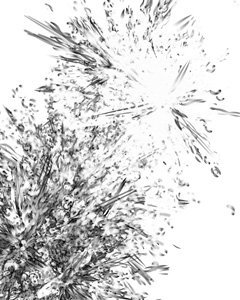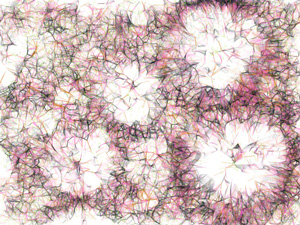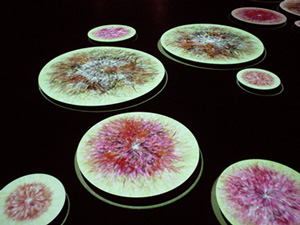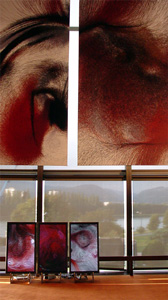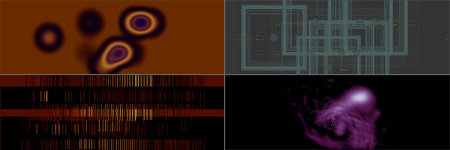Reas Casey
BIOGRAFIA
Reas è un artista ed insegnante, vive e lavora a Los Angeles. E’ un professore associato in Design, presso il dipartimento delle Arti dei Media dell’Università della California.
Dopo la laurea nel 1996 (summa cum laude) presso il DAAP (Design, Architecture, Art and Planning) dell’Università di Cincinnati, ha ottenuto il master in Media Arts and Sciences al MIT dove dal giugno del 1999 ad agosto del 2001 ha anche lavorato presso l’ACG (Gruppo Estetico e di Calcolo), sotto la guida del professor John Maeda.
Dal 2001 è ricercatore e professore associato all’Istituto di Interaction Design di Ivrea, in Italia, e presso l’UCLA Design.
Il suo lavoro è recentemente stato esposto all’“American Museum of Moving Image”, all’“Ars Electronica Center”, al “Cooper Union”, al “New York Digital Salon”, al “Museum of Modern Art”, al “Sega Joypolis” e al “Siggraph” e i suoi lavori sono stati pubblicati in giornali e libri internazionali.
Prima di diventar parte dell’ACG, ha lavorato come direttore di Design presso “I/O 360 Digital Design” di New York. Ha ricevuto il suo dottorato di laurea dal College of Design, Architecture, Art, and Planning dell’Università di Cincinnati.
SITO WEB
http://www.groupc.net/ (archivio di lavori dal 2001 al 2004)
http://acg.media.mit.edu/people/creas/ (archivio di lavori dal 1999 al 2001)
BIBLIOGRAFIA
- Behavioral Kinetic Sculture: (2001) tesi di dottorato, relatore John Maeda
- The Graphics Book D&AD, London. 2002
- Martini, Federica. "Sculpture Immateriali, Intervista a C.E.B. Reas." Exibart. December 2001
- "Interview: C.E.B. Reas." Design Net, Vol. 61. Seoul, Korea. October 2002
- Ha, Young-June. "Interview with C.E.B. Reas." Korea Tatler, Vol.03 No.22, August 2003
- Tan, Tori. "Processing: Interview with C.E.B. Reas." XFuns Magazine No.11. May 2004
- "Design Talk: Casey Reas. Processing." Computer Arts, UK. May 2005
Pubblicazioni 2006-2001:
- Who are the Progenitors of the Contemporary Synthesis of Software and Art?” The Anthology of Computer Art. Altena, Arie & Lucas van der Velden, Ed. COUP, Amsterdam. 2006
- “Process/Drawing.” Architectural Design. Programming Cultures: Design, Science and Software. Silver, Michael, Ed. John Wiley & Sons, London. 2006
- “Processing: Programming for the Media Arts.“ AI & Society Journal Special Issue. Springer Verlag, London. 2006
- "Processing Code." Aesthetic Computing. Paul Fishwick, Ed. MIT Press, Boston. 2006
- "MicroImage." A Minima 9. Espacio Publicaciones, Spain. 2005
- "The Language of Computers." Creative Code. John Maeda, Ed. Thames & Hudson, London, 2004
- "{Software} Structures." Read_Me, Software Art & Cultures. Goriunova, Olga & Alexei Shulgin, Eds. University of Aarhus Press. Aarhus, Denmark. 2004
- "Programming Media." InterCommunication No. 47. ICC. Winter, 2004
- "Programming Media." CODE - The Language of Our Times. Hatje Cantz Verlag. 2003
- Behavioral Kinetic Sculpture. The Art of Programming. Sonic Acts Press. 2002
POETICA
I suoi lavori si basano sulla definizione di processi e astrazioni esplorative attraverso diversi media digitali, e la loro traduzione in immagini.
OPERE
2004-2007:
- Processing (2005): progetto in collaborazione con Ben Fry; si tratta di un’innovativo linguaggio di programmazione, un’elegante interfaccia che permette a generazioni di persone di capire ed usare l’informatica e la progettazione come medium creativo.
- Processing 4, 5, 6, 7, 8, 9 (2005) softwares
- Image phase (2004) animazione
- Image for 18 musicians (2004) software
- Ti (2004 ) software
- Articulate (2004 ) software
- Microimage (2004 ) software
2001-2004:
- Dakadaka (software)
- Seoul B (software) realizzazione di disegni semiautomatici; si disegnano degli elementi su uno schermo che continueranno ad interagire a vicenda, generando “subpatterns” all’interno dei “macropatterns”.
- Seoul A (software)
- Ti (software) risultato di interazioni fra gli elementi di software autonomi.
- Articulate (software e web)
- Micro Image (software, animazione e stampa)
- Ora (software)
- Tissue (software e stampa)
- Hairy Red (stampa)
- Path (stampa)
- Hypnotext (web) in collaborazione con Peter Halley, commissionato da Peter Lunenfeld
- Conditional (web)
- D-Cell (web)
- Processing (2001)
- Mediation (animazione)
1999-2001:
- Trundle v 1.0, 1.1, 1.2
- Realtive Boxes
- Egg machine (2000) è un sistema audiovisivo interattivo.
- Plane modulator (2000 – premiato nel 2001 Silver Medal. 80th Annual Art Directors Club Awards) un sistema dinamico per lo studio dei rapporti e delle relazioni tra tempo e spazio., attraverso manipolazioni di un oggetto, creando nuove forme cinetiche.
- Relational Constructs
- Introspection machine (2000)
- Daka Daka (1999 – premiato nel 2000 Honorable Mention. Tokyo Type Directors Club) realizzato in collaborazione con Golan Levin

